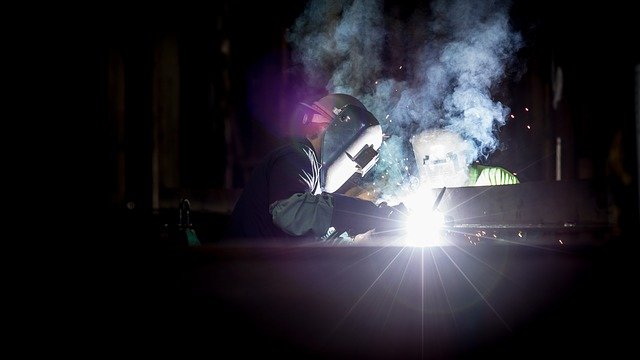We believe there are two things that nobody should compromise upon: Quality and Safety.
Our innovative product range has a consistent quality to meet all your welding needs while ensuring the safety of the people using the products.
Welding is one of the best processes to join metal together, but it also exposes welders to many hazards which can be harmful to one’s health. Following certain welding safety measures can minimize the chances of one getting harmed at all.

This article shares welding safety practices that should be followed diligently.
1. The manual is your Bible: An operating manual for welders has key information that explains welding machines and safety practices around it that needs to be followed. Along with these measures, the manual helps the welders tap into the machine's maximum potential. The manufacturer of the welding machine knows the best way to operate it and keeps welding safety on priority. Take it at face value and make it your go-to for any queries. Better safe than sorry!
2. Avoid looking at the welding arc: While fusing two metal pieces together, maintaining protection for one's eyes is a must. When a welding electrode strikes the work piece an arc generates which is harmful for the eyes therefore, safety must always be observed when using welding machinery, that is, if one's eyesight is dear to them. Wearing the right helmet adds to safe welding practices and helps the welder prevent any kind of physical damage. Along with the eyes, the lungs, skin, ears,etc.
3. Gear up: No casual clothing can do justice to welding safety while performing welding. No matter how big or small the welding task at hand is, proper gear must be worn. This includes a helmet with efficient barriers, gloves, and clothing that matches the welding safety measures. All clothing should be flame resistant. A proper welding jacket is not just advised but there is no other substitute and it must be worn.
4. A clean working area is ideal: A cluttered working space leaves one with a lesser working area, rendering silly hazards more likely. Each welding consumable must be placed safely and as per the need and requirement of it for the task at hand. Ideally, only the equipment required should be around.
5. Save room for breathing: Smoke and fumes emerges during the process of welding which can pose serious health hazards that will manifest in the long run as lung infections and breathing difficulties. This toxicity needs to be avoided at all times. While performing the welding process, use safety measures like an exhaust hood. The hood makes room for breathable air to come in and the toxic fumes to pass through. These respiration helpers are specifically made for welding, so ask us today to know more about such safety equipment!
Pro tip: Loose all matches and lighters on or around you to avoid fire hazards.
11 May 2025 | Welding
An In-Depth Exploration of Low-Alloy Steel: Your Comprehensive Guide
11 May 2025 | Welding
Nagpur - Bori - Tuljapur Road MSH-3 in Yavatmal District (Maharashtra)
11 May 2025 | Welding
Guidelines to Understand Gas Welding: Applications, Advantages & Disadvantages
11 May 2025 | Welding
3 Tips for Finding the Best Mild Steel Electrode for Your Application
11 May 2025 | Welding
How to Select the Right Welding Filler Wires for Stainless Steel Welding?
11 May 2025 | Welding
Building the Narendra Modi Stadium with Norma V and Autotherme-1 Electrodes
11 May 2025 | Welding
Low Alloy Steel Welding in a (PEB) Pre Engineered Building Structure
11 May 2025 | Welding
Welding Rods: Different Types and Tips for Properly Storing and Handling
11 May 2025 | Welding
Tips for Flawless Welds with Stainless Steel Electrodes: Pros and Cons
11 May 2025 | Welding
Exploring Applications and Benefits of Stainless Steel Welding Electrodes
11 May 2025 | Welding
Welding Basics: Joining Metals with Heat and Pressure - A Beginners Guide
11 May 2025 | Welding
Distinguishing Low-Alloy Steel from High-Alloy Steel: Understanding the Variations
11 May 2025 | Welding
Hard Facing Wire - Understanding the Process and Achieving Optimal Result
11 May 2025 | Welding
Exploring the Advantages of Stainless Steel Electrodes in Welding Applications
11 May 2025 | Welding
Weathering Steel vs. Traditional Steel: A Comparative Analysis of Performance
11 May 2025 | Welding
Choosing the Right Welding Rod: Why 6013 Electrodes Might Be Your Ideal Option
11 May 2025 | Welding
Why 7018 Electrodes Are Preferred for High-Strength Welds in Pipeline Construction
11 May 2025 | Welding
Filler Wire vs. Stainless Steel Filler Wire: Understanding the Key Differences
11 May 2025 | Welding
Exploring the Impact of Filler Material on Welding Quality and Durability
11 May 2025 | Welding
Choosing the Right Cast Iron Electrode for Different Welding Projects
11 May 2025 | Welding
Top Advantages of Cast Iron Electrodes for Industrial Welding Applications
11 May 2025 | Welding
Key Benefits and Challenges of Using TIG Welding in Industrial Projects
11 May 2025 | Welding
5 Reasons Why 7018 Electrode is the Gold Standard for Welding Professionals
11 May 2025 | Welding
Top 5 Advantages of Flux Cored Arc Welding for Heavy-Duty Applications.png)
11 May 2025 | Welding
Lotherme-601: A Game-Changer for Restoring Shoulder Pins in Heavy Machinery
11 May 2025 | Welding
How D&H Sécheron Helped Repair a Rotary Kiln’s Cooler Section with LoTherme 352
11 May 2025 | Welding
Piston Repair for Mining Industry: Cost-Effective Solutions with LoTherme 468.webp)





.jpg)








































.jpg)
.jpg)

.jpg)

.jpg)





.jpg)
.jpg)
.jpg)



.webp)
.jpg)
.jpg)
.webp)
.jpg)






















.png)



.webp)

.webp)
.webp)



